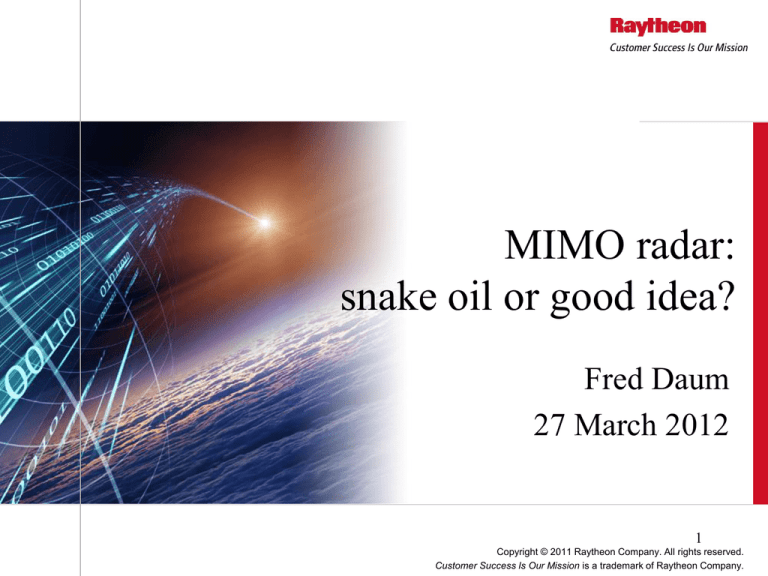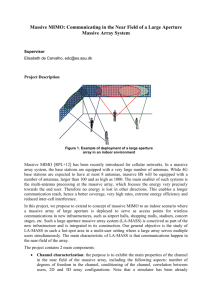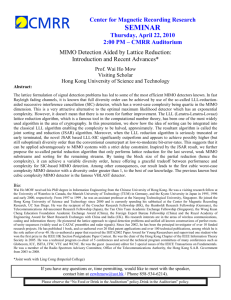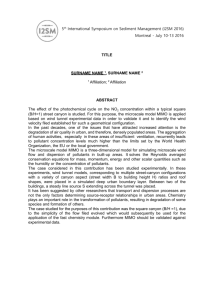
MIMO radar:
snake oil or good idea?
Fred Daum
27 March 2012
1
Copyright © 2011 Raytheon Company. All rights reserved.
Customer Success Is Our Mission is a trademark of Raytheon Company.
MIMO* radar vs. phased array radar (SIMO)
item
MIMO radar
1. waveforms
N orthogonal waveforms
transmitted simultaneously
from N distinct parts of the
antenna
2. transmit antenna pattern
(array factor)
omni directional (except
for element pattern or
subarray pattern)
3. transmit antenna gain
(array factor)
4. SNR
5. time on target
(T or T*)
phased array radar
one waveform transmitted
from the radar (coherently)
pencil beam:
θ ≈ λ/D
G/N
G
cT*/N
cT
full transmit duty cycle
(limited by coherence of
target & propagation)
limited by pencil beam
6. useful range-Doppler
space (normalized area)
1/N
1
7. number of degrees of
freedom for adaptive nulling
NM
M
*MIMO = multiple input multiple output
2
MIMO Radar – Virtual Array
ej2p(ft-x/l)
ej2p(ft-x/l)
q
q
dR
f2(t)
dT=NdR
f1(t)
MF … MF
…
f0(t)
Transmitter: M antenna elements
Receiver: N antenna elements
q
Virtual array: NM elements
RADAR PERFORMANCE
MIMO better than boring old phased
array (equal cost, apples & apples
comparison)*
REFERENCES
search (thermal noise only)
no (increased angle coverage is
cancelled by loss of transmit antenna
gain)
Friedlander (2009)
Chernyak (2008)
Rabideau (2011)
track (thermal noise only)
no (no improvement in SNR & MIMO
does not exploit knowledge of target to
steer transmit beam) but TWS maybe
Vaidyanathan (2010)
Li, Stoica & Daum (2010)
barrage jamming
no (non-responsive jammer doesn’t see
waveform diversity)
Rabideau (2004)
Greenspan (2009)
DRFM mainbeam & sidelobe jamming or other
responsive jamming (fast set on)
passive ranging with network of radars
works (but simple multi-static
competes well with MIMO also)
Rabideau (2004)
mitigation of spread Doppler clutter for OTH
radar (like ROTHR using TWS)
good idea sometimes (SNR loss maybe
too high & simple spatial diversity
competes well with MIMO)
Frazer (2008)
Krolik (2004)
improved angle measurement accuracy (onesigma error due to front end noise)
factor of √2 to roughly factor of 10
improvement sometimes
Tabrikian (2008)
Friedlander (2009)
adaptive suppression of sidelobes & grating
lobes for sparse array
MN degrees of freedom vs. only M
degrees of freedom helps
Chen’s CalTech thesis (2009)
relaxed requirement on instantaneous dynamic
range against clutter
MIMO improves CNR for certain clutter
& certain radars & some targets
Rabideau (2004)
suppression of sea clutter or ground clutter
depends on the radar & clutter (GMTI
often good but long range fast targets
bad)
Rabideau (2008)
Bliss et al. (2009)
Abramovitz & Fraser (2009)
face combining for SPY-1, SPY-3, PAVE PAWS,
BMEWS, UEWR, AMDR
3 dB to 9 dB better SNR at large scan
angles
this is multi-static radar not real time
MIMO radar (Zatman 2008)
multiple radar combining
3 dB to 9 dB better SNR for two radars
& more for N radars
Coutts, Cuomo, McHarg, Robey,
4 MIMO
Weikle (2007); but not real time
*good cost models for MIMO & SIMO are crucial
HF OTH radar* (Krolik 2008)
PHASED ARRAY
spread Doppler
clutter
MIMO
target
*issues of sample covariance matrix estimation, SNR loss, competition from non-MIMO spatial diversity,5
lack of orthogonal waveforms in the real World, loss of useful range-Doppler space, etc.
MIMO nulls spread Doppler clutter with
adaptive transmit pattern
6
GMTI is often a good niche* application of
MIMO radar
fast speed
targets
slow speed
targets
short range
long range
loss of useful
range-Doppler
space too much
loss of SNR too much
& loss of useful
range-Doppler space
too much
GMTI
loss of SNR
too much
*terminology due to Dan Bliss (11 February 2009) at Orlando airport
7
Bliss, et al., “GMTI MIMO
radar,” IEEE Waveform
diversity Conference,
Orlando, Feb. 2009.
(1) coherent integration time is 5
times longer for MIMO than
boring old phased array.
(2) surveillance mode.
(3) MIMO uses 5 element sparse
transmit array, whereas PA uses
smaller filled transmit array.
(4) both MIMO & PA use 5
element filled receive array.
(5) total transmit power is the
same for MIMO & PA.
(6) frequency = 2 GHz.
(7) simulation of textbook
clutter (spatially homogeneous)
8
Bliss, et al., “GMTI MIMO
radar,” IEEE Waveform
diversity Conference,
Orlando, Feb. 2009.
(1) coherent integration time is
5 times longer for MIMO
than boring old phased
array.
(2) surveillance mode.
(3) MIMO uses 5 element
sparse transmit array,
whereas PA uses filled
transmit array.
(4) both MIMO & PA use 5
element filled receive
array.
(5) total transmit power is the
same for MIMO & PA.
(6) theoretical error bound for
textbook clutter (spatially
homogeneous)
9
QUIZ:
• (1) Why can’t the boring old phased array radar use a
pulse-Doppler waveform to get the same 5 times longer
coherent integration time as the MIMO radar?
• (2) Why is the sparse transmit array for the MIMO radar 5
times larger than the transmit array for the boring old
phased array radar?
• (3) Why not compare performance & cost of the MIMO &
boring old phased array radar (with 5x larger sparse
transmit array or 5x larger filled transmit array) directly?
• (4) Why not make the receive array 5 times larger, rather
than the transmit array?
• (5) Why not use X-Band or higher frequency rather than LBand to get much better Doppler resolution & accuracy?
10
MIMO radar* requires much tighter coupling
between design specialties than boring old
phased array radars
antenna
design
waveform
design
signal
processing
design
system
testing
system
engineering
software
design
11
*also intimidating & complex & risky & 95% snake oil
12
Correct
apples & apples
analysis!
Pd=0.9
Phased Array
radar
Pd=0.99
MIMO
radar
13
(from Alex Haimovich, Rick Blum, et al., IEEE Trans. Sig Proc 2006 )
Typical Radar Cross Section (RCS) vs.
Azimuth Angle
Radar cross section of the
B-26 bomber at 3 GHz as a
function of azimuth angle.
From: Introduction to Radar
Systems, Merrill I Skolnik,
McGraw-Hill, NY, 1962
14
15
(1) Yuri Abramovich & Gordon Frazer,
“Bounds on the volume and height
distributions for the MIMO radar
ambiguity function,” IEEE Signal
Processing Letters, 2008.
Generalization of Bob Price’s
theorem (1965). MIMO has
factor of N smaller useful
range-Doppler space than
boring old phased array.
(2) Benjamin Friedlander, “On the
relationship between MIMO and SIMO
radars,” IEEE Trans. Signal Processing,
January 2009.
Very clear & explicit
quantification of apples &
apples performance
comparison MIMO vs. PA
(3) Victor Chernyak, “About the “new” Statistical MIMO radar is not
concept of statistical MIMO radar,”
“new” and not as good as
Proceedings of Radar Conference, 2008. boring old phased arrays.
(4) Victor Chernyak, “Fundamentals of
multisite radar systems,” translated
from Russian, Gordon & Breach (1998).
Russian edition published 1993.
Basic reference on multiradar systems with correct
apples & apples comparisons
and correct physical models.
16
(5) Gordon Frazer, et al., “Recent
results in MIMO OTH radar,”
Proceedings of IEEE Radar Conference,
Rome May 2008.
Real world system
engineering viewpoint on
MIMO radar for OTH
applications
(6) Gordon Frazer, et al., “Spatially
waveform diverse radar: perspectives
for HF OTHR,” Proceedings of IEEE
Radar Conference, Boston April 2007.
How to prevent MIMO
radar transmitter from
melting or exploding (see
next chart)
(7) Dan Rabideau, “Adaptive MIMO
Simple back-of-theradar waveforms,” Proceedings of IEEE envelope formulas & good
Radar Conference, Rome May 2008.
solid radar system
engineering!
(8) Fred Daum, “MIMO radar: snake
oil or good idea?” Proceedings of IEEE
Asilomar Conference, October 2008.
Practical nuts & bolts hard
boiled system engineering
perspective.
17
BACKUP
18
MIT Lincoln Lab radar combining algorithm (Coutts, Cuomo,
McHarg, Weikle & Robey, IEEE radar conference 2006)
19
MIMO radar waveforms for GMTI
waveform class
distributed
clutter
FDMA
(frequency)
loss of coherence
CDMA
(code)
clutter fills the
usable rangeDoppler space
TDMA
(time)
very inefficient
use of the
transmitter
point clutter
loss of coherence
references
Rabideau (2008)
& Bliss, et al.
(2009)
Abramovich &
Fraser (2008)
Bliss et al. (2009)
very inefficient
use of the
transmitter
Rabideau (2008)
& Bliss, et al.
(2009)
DDMA
(Doppler)
Russians (1980) &
Krolik, et al.
(2004)
space-time
waveforms &
hybrids of above
Rabideau (2008)
and Abramovich &
Fraser (2008) 20
???
???
hot off the press MIMO radar papers:
(1) Yu, Petropulu & Poor, “MIMO radar & compressive sensing,” 2011.
(2) Chen & Vaidyanathan, “Compressed sensing in MIMO radar,” 2011.
(3) Strohmer & Friedlander, “Compressed sensing for MIMO radar,”
2011.
(4) Willett, et al., “Compressed sensing for MIMO radar,” 2011.
(5) Vaidyanathan & Pal, “MIMO radar, SIMO radar & IFIR radar,” 2011.
(6) Hassanien & Vorobyov, “Why the phased-MIMO radar outperforms
the phased array and MIMO radars,” 2011.
21
six ways to understand why MIMO improves
angular measurement accuracy
more equations to
compute
unknowns (MN vs.
N)
geometry (more
triangles determine
target location
more accurately)
reciprocity of
receive & transmit
algebra (i.e.,
compute CramerRao bound for
MIMO)
virtual array
antenna patterns
(i.e., composite
transmit-receive
pattern)
22
Bliss, et al., “GMTI MIMO
radar,” IEEE Waveform
diversity Conference,
Orlando, Feb. 2009.
(1) Coherent integration time
is 5 times longer for MIMO
than boring old phased array.
(2) Surveillance mode.
(3) MIMO uses 5 element
sparse transmit array,
whereas PA uses smaller
filled transmit array.
(4) Both MIMO & PA use 5
element filled receive array.
(5) Total transmit power is
the same for MIMO &
boring old PA.
(6) frequency = 2 GHz.
23
Bliss, et al., “GMTI
MIMO radar,” IEEE
Waveform diversity
Conference, Orlando,
Feb. 2009.
(1) Coherent integration
time is 5 times longer
for MIMO than boring
old phased array.
(2) Surveillance mode.
(3) MIMO uses 5 element
sparse transmit array,
whereas PA uses filled
transmit array.
(4) Both MIMO & PA use 5
element filled receive
array.
(5) Total transmit power is
the same for MIMO &
24
boring old PA.
25
Dan Rabideau (2008):
To date, the MIMO radar community has largely assumed
the use of "orthogonal" waveforms (i.e., waveforms having
zero cross-correlation). To approximate orthogonality,
some practitioners have proposed waveforms that exhibit
both low cross-correlation and low autocorrelation
sidelobes. As we shall see, lowering auto/cross correlation
levels will indeed reduce decorrelation. However, in many
cases this approach still results in unsatisfactory
interference rejection levels.
26
Simple back-of-the-envelope formula
(Rabideau 2008):
We can use (4) - (11) to approximate the MCR at high
CNR as:
MCR == 1-1/(1 + IASR + ICCR)2
where IASR is the integrated autocorrelation sidelobe
power
ratio, and lCCR is the integrated cross-correlation ratio.
For
pseudorandom waveforms, IASR ~ (2L - 2)/(2L) , and
ICCR ~ (2L -1)/(2L). Hence, (12) predicts an MCR of
only
-0.5 dB. Computer simulations confirm this prediction.
27
2nd simple back-of-the-envelope formula
(Rabideau 2008):
[for up/down chirps] it can be shown that:
MCR ~ 1- (1 + IASR)2 /(1 + IASR + ICCR)2
From (13) we expect an MCR of -1.3 dB.
Direct computer simulations also confirmed
this value.
Note that approximations like (12) and (13)
allow us to evaluate entire waveform classes
using only gross auto/cross correlation
characteristics.
28
Professor Chernyak on statistical MIMO radar:
There is nothing new in the “statistical MIMO
radar concept”….The SIMO radar (with the same
total energy) is much better than the MIMO and
MISO systems….It is clear that we have a good
combination of high incident energy on a target
with fluctuation smoothing on the receiving
side….The target and signal model suggested by
the authors of statistical MIMO radar does not
correspond to the physical nature of signal
fluctuations at the input of a radar receiver.
29
item
comments
references
1. Loss in SNR
Factor of N loss for MIMO
Li & Stoica (2009)
2. Loss in useful range-Doppler
space
Factor of N loss for MIMO
Abramovich & Frazer (2008)
3. Cost
N antennas, N sites, N² receivers, N waveform
generators, calibration of N² channels, data links,
complex signal & data processing, testing, etc.
Skolnik (1962)
4. Risk
Complexity & novelty & tight coupling of designs
Skolnik (1962)
5. Melting or explosion of
transmitter
Energy radiated into imaginary space by standard
MIMO design
Frazer (2007)
6. Low transmit antenna gain
Jamming, radiation hazard, anti-radiation homing
missiles, NTIA standards, EMC, ducting
Skolnik (1962)
7. Time & frequency agility
Decorrelates RCS for phased array (PA) to enhance
detection probability
Skolnik (1962)
8. Time & frequency agility
Decorrelates multipath for PA
Barton (1964)
9. Exploit time for tracking
Sequence of high gain beams for PA
Friedlander (2009)
10. Exploit time for ECCM
Sequence of high gain beams to null jammers for PA
Friedlander (2009)
11. Range & Doppler resolution for
PA
Angle resolution is usually irrelevant for resolution
of multiple targets
Skolnik (1962)
12. Mitigation of multipath for PA
Wideband waveforms, adaptive nulling, optimal
receive & transmit beams, nonlinear filters
Skolnik (2008)
13. Smart design of PA
Smart MIMO design vs. dumb PA design
Skolnik (2008)
14. Limits on coherent integration
time for MIMO to increase SNR
Target coherence, propagation path (troposphere &
ionosphere & multipath) & transmitter duty cycle
Skolnik (2008)
15. Data association errors with
MIMO
PA is simple & robust
Bar-Shalom & Blackman 30
books
item
comments
references
1. Loss in SNR
Factor of N loss for MIMO
Li & Stoica (2009)
2. Loss in useful rangeDoppler space
Factor of N loss for MIMO
Abramovich & Frazer
(2008)
3. Cost
N antennas, N sites, N² receivers, N
waveform generators, calibration of N²
channels, data links, complex signal &
data processing, testing, etc.
Skolnik (1962)
4. Risk
Complexity & novelty & tight coupling of
designs
Skolnik (1962)
5. Melting or explosion of
transmitter
Energy radiated into imaginary space by
standard MIMO design
Frazer (2007)
6. Low transmit antenna
gain
Jamming, radiation hazard, anti-radiation
homing missiles, NTIA standards, EMC,
ducting
Skolnik (1962)
7. Time & frequency agility
Decorrelates RCS for phased array (PA)
to enhance detection probability
Skolnik (1962)
8. Time & frequency agility
Decorrelates multipath for PA
Barton (1964)
9. Exploit time for tracking
Sequence of high gain beams for PA
Friedlander (2009)
10. Exploit time for ECCM
Sequence of high gain beams to null
jammers for PA
Friedlander (2009)
31
Please exploit all flavors of diversity, not just
waveform diversity
time
spatial
polarization
frequency
waveform
32
item
comments
references
7. Time & frequency agility
Decorrelates RCS for phased array (PA)
to enhance detection probability
Skolnik (1962)
8. Time & frequency agility
Decorrelates multipath for PA
Barton (1964)
9. Exploit time for tracking
Sequence of high gain beams for PA
Friedlander (2009)
10. Exploit time for ECCM
Sequence of high gain beams to null
jammers for PA
Friedlander (2009)
11. Range & Doppler
resolution for PA
Angle resolution is usually irrelevant for
resolution of multiple targets
Skolnik (1962)
12. Mitigation of multipath
for PA
Wideband waveforms, adaptive nulling,
optimal receive & transmit beams,
nonlinear filters
Skolnik (2008)
13. Smart design of PA
Smart MIMO design vs. dumb PA design
Skolnik (2008)
14. Limits on coherent
integration time for MIMO
to increase SNR
Target coherence, propagation path
(troposphere & ionosphere & multipath)
& transmitter duty cycle
Skolnik (2008)
15. Data association errors
with MIMO
PA is simple & robust
Bar-Shalom &
Blackman books
33
MIMO
target
“Like traditional STAP methods, the challenge of estimating the
clutter covariance matrix from the received data is difficult in
slow-time MIMO STAP. Further work is required to determine
an appropriate set of training data from which the MIMO adaptive
weights can be calculated.”
Mecca, Ramakrishnan & Krolik (2008)
34
MIMO for Radar vs. Communication
Comm
Microwave
radar
1. Omni transmit
OK?
yes!
no!
Large loss of energy
on target in track,
which cannot be
recovered.
2. Long time on
target?
yes!
no!
yes (track-whilescan)
3. Long coherence
time?
yes
no
yes (owing to long
wavelength)
4. Tolerance for
hiatus in music
none
large
5. Performance
measure
6. Exploit frequency
agility & time &
bandwidth?
Shannon
information
not generally
SNR or SJR or SCR
or detection
probability or range
& angle & Doppler
accuracy
yes
HF OTH radar
yes
(track-while-scan)
some
SNR or SJR or SCR
or detection
probability or range &
angle & Doppler
accuracy
generally not 35
MIMO
target
“Like traditional STAP methods, the
challenge of estimating the clutter covariance
matrix from the received data is difficult in
slow-time MIMO STAP. Further work is
required to determine an appropriate set of
training data from which the MIMO
adaptive weights can be calculated.”
Mecca, Ramakrishnan & Krolik (ref. 5)
Translation:
“Send more
money”
36
Fig. 2. Photograph of the OTHR transmitter array used in the HILOW experiment and taken from directly in front of the array. The
37
array comprises fourteen log periodic dipole array elements arranged as an equi-spaced linear array. The eight center elements
were
used in the experiment.
Fig. 3. Spectrogram of the output of one waveform generator and high power amplifier for the case of
a staggered linear FMCW waveform set. The signal shown corresponds to one member of the
waveform set and is the signal radiated from one transmit array element. dBJ
38
Fig. 4. Spectrogram of the received waveform set following two-way propagation. All members
of the waveform set are shown. The substantial clutter propagation range depth typical in OTHR
is apparent and shows as a “thickening” of each individual chirp. It reduces the time-frequency
spacing between members of the waveform set. Such range (and while not shown here,
Doppler) spread is typical in OTHR and reduces the practically realisable cardinality of any
chosen waveform set.
39
Fig. 5. Doppler-delay map for the two-way signal received using a single channel radar receiver. The RD
map shows earth return clutter and multi-mode radar measurements of a radar transponder located in the
one-hop footprint of the radar. Of particular interest are the first and third (of five) transponder returns, at
8.47ms and 9.01ms delay at approximately 1.7Hz Doppler shift. The receiver signal was processed
using multiple matched filters - one per waveform set member - and this diagram corresponds to the RD
map in the direction of the peak of a transmitter beam based on maximising the 8.47ms transponder
40
return implemented as a weighted sum of the output of the multiple matched filters.
Fig. 6. Transmit beampattern formed at the one-way path receive location
in the one-hop footprint of the OTHR at a location close to the transponder.
The two beampatterns correspond to the 8.47ms and 1.7Hz transponder mode
and the 9.01ms and 1.7Hz transponder mode identified in Fig. 5.
41
Fig. 7. Transmit beampattern formed at the two-way path OTHR receive
location. The two beampatterns correspond to the 8.47ms and 1.7Hz
transponder mode and the 9.01ms and 1.7Hz transponder mode identified in
Fig. 5.
42
angle estimation
accuracy (IEEE Trans Signal
Processing Oct 2006)
Phased
Array
Explain this
intuitively
Severe
degradation
due to transmit
beamshape loss
MIMO
Subtle detail
43
angle estimation accuracy (IEEE
Trans Signal Processing Oct 2006)
Both plots are
optimistic by
two orders of
magnitude!
Phased
Array
MIMO
44
angle estimation
accuracy for 2 unresolved
targets (IEEE Trans SP Oct)
phased
array
MIMO
45
MIMO vs. phased array for jamming
46
MIMO vs. phased array for jamming
47
MIMO vs. phased array for jamming
48
MIMO vs. phased array for jamming
49
MIMO vs. phased array for jamming
50
MIMO Radar
• MIMO communications is clearly a good
idea for certain applications in theory
• Asserted advantages of MIMO radar
• Apples & apples comparison of MIMO
radar vs. boring old phased array radar
• New excellent references
• Story about Russian visitor to Raytheon
25 years ago
51







